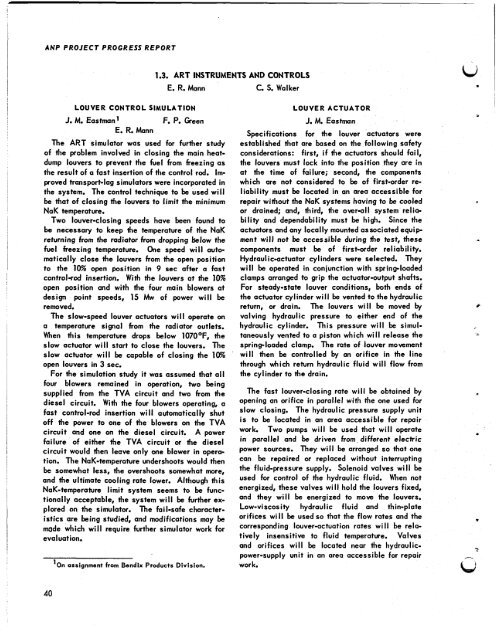ORNL-2106 - the Molten Salt Energy Technologies Web Site
ORNL-2106 - the Molten Salt Energy Technologies Web Site
ORNL-2106 - the Molten Salt Energy Technologies Web Site
Create successful ePaper yourself
Turn your PDF publications into a flip-book with our unique Google optimized e-Paper software.
ANP PROJECT PROGRESS REPORT<br />
LOUVER CONTROL SIMULATION<br />
i. M. Eastman' F. P. Creen<br />
E. R. Mann<br />
The ART simulator was used for fur<strong>the</strong>r study<br />
of <strong>the</strong> problem involved in closing <strong>the</strong> main heat-<br />
dump louvers to prevent <strong>the</strong> fuel from freezing as<br />
<strong>the</strong> result of a fast insertion of <strong>the</strong> control rod. Im-<br />
proved transport-lag simulators were incorporated in<br />
<strong>the</strong> system. The control technique to be used will<br />
be that of closing <strong>the</strong> louvers to limit <strong>the</strong> minimum<br />
NaK temperature.<br />
Two louver-closing speeds have been found to<br />
be necessary to keep <strong>the</strong> temperature of <strong>the</strong> NaK<br />
returning from <strong>the</strong> radiator from dropping below <strong>the</strong><br />
fuel freezing temperature. One speed will auto-<br />
matically close <strong>the</strong> louvers from <strong>the</strong> open position<br />
to <strong>the</strong> 10% open position in 9 sec after a fast<br />
control-rod insertion. With <strong>the</strong> louvers at <strong>the</strong> 10%<br />
open position and with <strong>the</strong> four main blowers at<br />
design point speeds, 15 Mw of power will be<br />
removed.<br />
The slow-speed louver actuators will operate on<br />
a temperature signal from <strong>the</strong> radiator outlets.<br />
When this temperature drops below 1O7O0F, <strong>the</strong><br />
slow actuator will start to close <strong>the</strong> louvers. The<br />
slow actuator will be capable of closing <strong>the</strong> 10%<br />
open louvers in 3 sec.<br />
For <strong>the</strong> simulation study it was assumed that all<br />
four blowers remained in operation, two being<br />
supplied from <strong>the</strong> TVA circuit and two from <strong>the</strong><br />
diesel circuit. With <strong>the</strong> four blowers operating, a<br />
fast control-rod insertion will automatically shut<br />
off <strong>the</strong> power to one of <strong>the</strong> blowers on <strong>the</strong> TVA<br />
circuit and one on <strong>the</strong> diesel circuit. A power<br />
failure of ei<strong>the</strong>r <strong>the</strong> TVA circuit or <strong>the</strong> diesel<br />
circuit would <strong>the</strong>n leave only one blower in opera-<br />
tion. The NaK-temperature undershoots would <strong>the</strong>n<br />
be somewhat less, <strong>the</strong> overshoots somewhat more,<br />
and <strong>the</strong> ultimate cooling rate lower. Although this<br />
NaK-temperature limit system seems to be func-<br />
tionally acceptable, <strong>the</strong> system will be fur<strong>the</strong>r ex-<br />
plored on <strong>the</strong> simulator. The fail-safe character-<br />
istics are being studied, and modifications may &<br />
made which will require fur<strong>the</strong>r simulator work for<br />
evaluation.<br />
40<br />
'On assignment from Bendix Products Division.<br />
1.3. ART INSTRUMENTS AND CONTROLS L)<br />
E. R. Mann<br />
C. S. Walker 8<br />
LOUVER ACTUATOR<br />
J. M. Eastman<br />
Specifications for <strong>the</strong> louver actuators were<br />
established that are based on <strong>the</strong> following safety<br />
considerations: first, if <strong>the</strong> actuators should fail,<br />
<strong>the</strong> louvers must lock into <strong>the</strong> position <strong>the</strong>y are in<br />
at <strong>the</strong> time of failure; second, <strong>the</strong> components<br />
which are not considered to be of first-order re-<br />
liability must be located in an area accessible for<br />
repair without <strong>the</strong> NaK systems having to be cooled<br />
or drained; and, third, <strong>the</strong> over-all system relia-<br />
bility and dependability must be high. Since <strong>the</strong><br />
actuators and any locally mounted associated equip-<br />
ment will not be accessible during <strong>the</strong> test, <strong>the</strong>se<br />
components must be of first-order reliability.<br />
Hydraul ic-actuator cy1 inders were selected. They<br />
will be operated in conjunction with spring-loaded<br />
clamps arranged to grip <strong>the</strong> actuator-output shafts.<br />
For steady-state louver conditions, both ends of<br />
<strong>the</strong> actuator cylinder will be vented to <strong>the</strong> hydraulic<br />
return, or drain. The louvers will be moved by<br />
valving hydraulic pressure to ei<strong>the</strong>r end of <strong>the</strong><br />
hydraulic cylinder. This pressure will be simul-<br />
taneously vented to a piston which will release <strong>the</strong><br />
spring-loaded clamp. The rate of louver movement<br />
will <strong>the</strong>n be controlled by an orifice in <strong>the</strong> line<br />
through which return hydraulic fluid will flow from<br />
<strong>the</strong> cylinder to <strong>the</strong> drain.<br />
The fast louver-closing rate will be obtained by<br />
opening an orifice in parallel with <strong>the</strong> one used for<br />
slow closing. The hydraulic pressure supply unit<br />
is to be located in an area accessible for repair<br />
work. Two pumps will be used that will operate<br />
in parallel and be driven from different electric<br />
power sources. They will be arranged so that one<br />
can be repaired or replaced without interrupting<br />
<strong>the</strong> fluid-pressure supply. Solenoid valves will be<br />
used for control of <strong>the</strong> hydraulic fluid. When not<br />
energized, <strong>the</strong>se valves wi II hold <strong>the</strong> louvers fixed,<br />
and <strong>the</strong>y will be energized to move <strong>the</strong> louvers.<br />
Low-viscosity hydraulic fluid and thin-plate<br />
orifices will be usedso that <strong>the</strong> flow rates and <strong>the</strong><br />
corresponding louver-actuation rates wi II be rela-<br />
tively insensitive to fluid temperature. Valves<br />
and orifices will be located near <strong>the</strong> hydraulic-<br />
power-supply unit in an area accessible for repair<br />
work.<br />
.<br />
I<br />
i<br />
*<br />
1<br />
A<br />
k.'



![Review of Molten Salt Reactor Physics Calculations [Disc 2]](https://img.yumpu.com/21979492/1/190x247/review-of-molten-salt-reactor-physics-calculations-disc-2.jpg?quality=85)













